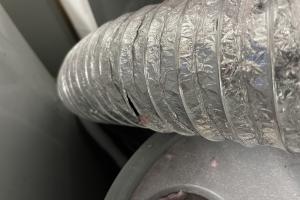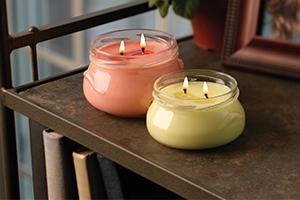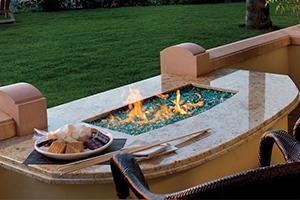Preventing clothes dryer fires

Clothes dryers account for about 15,600 fires each year, according to the U.S. Consumer Product Safety Commission (CPSC). Fires can occur when lint builds up in the dryer or in the exhaust duct. Lint can block the flow of air causing excessive heat build-up resulting in a fire.
“Failure to clean” is the number one contributing factor to dryer fires, according to data compiled by the U.S. Fire Administration. Dryer vents obstructed by lint may cause a rise in temperature sufficient to ignite the lint or nearby combustibles. By following these safety tips the likelihood of having a dryer fire caused by lint buildup can be greatly reduced.
CPSC recommends the following to reduce the likelihood of dryer fires:
Clean and inspect the lint screen/filter before or after drying each load.
If the load is still damp at the end of a typical drying cycle or drying times are longer than normal, the lint screen or the exhaust duct may be blocked.
Clean the dryer vent and exhaust duct periodically.
Check the outside dryer vent while the dryer is operating to make sure exhaust air is escaping. If it is not, the vent or the exhaust duct may be blocked. It may be necessary to disconnect the exhaust duct to remove a blockage. Remember to reconnect the ducting before using the dryer again. The Chimney Safety Institute of America recommends at least annual inspection by a qualified technician to help assure the dryer is properly vented and that the vent is free from lint, as well as nesting animals.
Clean behind the dryer, where lint can build up.
Have a qualified service person clean the interior of the dryer chassis periodically to minimize the amount of lint accumulation.
Keep the area around the dryer clean and free of clutter.
As a good fire safety practice, combustibles such as clothing, boxes and other items should not be placed near or around the dryer. Maintain a 36 inch clear space around dryer equipment. Laundry areas should be kept neat and clutter-free.
Replace plastic or foil, accordion-type ducting material with rigid or corrugated semi-rigid metal duct.
Exhaust ducts should be installed at least 6 inches from combustible materials. Dryer manufacturers recommend rigid or corrugated semi-rigid metal duct. Plastic or foil type duct can more easily trap lint and is more susceptible to kinks or crushing, which can greatly reduce airflow. The American Household Appliance Manufacturers Association recommends the use of UL-listed rigid aluminum or steel duct or spiral wound aluminum flex hose.
Gas-powered dryers must be properly vented to help prevent a build-up of deadly carbon monoxide.
In addition, the Federal Emergency Management Agency (FEMA) recommends having the gas line and connection inspected annually by a professional to help ensure they are intact.
Outside wall dampers should have a covering that will keep out rain, snow and dirt.
However, do not use wire screen or cloth of any kind to protect the exhaust opening. It can collect lint and clog areas of the dryer vent. In order to deter birds and small animals from nesting in vents, make sure the dryer vent system and damper are working.
Take special care when drying clothes that have been soiled with volatile chemicals such as gasoline, cooking oils, cleaning agents, or finishing oils and stains.
If possible, wash the clothing more than once to minimize the amount of volatile chemicals on the clothes and, preferably, hang the clothes to dry. If using a dryer, use the lowest heat setting and a drying cycle that has a cool-down period at the end of the cycle. To prevent clothes from igniting after drying, do not leave the dried clothes in the dryer or piled in a laundry basket.
Related resources
Preventing clothes dryer fires
Clothes dryers account for about 15,600 fires each year, according to the U.S. Consumer Product Safety Commission (CPSC). Fires can occur when lint builds up in the dryer or in the exhaust duct. Lint can block the flow of air causing excessive heat build-up resulting in a fire.
“Failure to clean” is the number one contributing factor to dryer fires, according to data compiled by the U.S. Fire Administration. Dryer vents obstructed by lint may cause a rise in temperature sufficient to ignite the lint or nearby combustibles. By following these safety tips the likelihood of having a dryer fire caused by lint buildup can be greatly reduced.
CPSC recommends the following to reduce the likelihood of dryer fires:
Clean and inspect the lint screen/filter before or after drying each load.
If the load is still damp at the end of a typical drying cycle or drying times are longer than normal, the lint screen or the exhaust duct may be blocked.
Clean the dryer vent and exhaust duct periodically.
Check the outside dryer vent while the dryer is operating to make sure exhaust air is escaping. If it is not, the vent or the exhaust duct may be blocked. It may be necessary to disconnect the exhaust duct to remove a blockage. Remember to reconnect the ducting before using the dryer again. The Chimney Safety Institute of America recommends at least annual inspection by a qualified technician to help assure the dryer is properly vented and that the vent is free from lint, as well as nesting animals.
Clean behind the dryer, where lint can build up.
Have a qualified service person clean the interior of the dryer chassis periodically to minimize the amount of lint accumulation.
Keep the area around the dryer clean and free of clutter.
As a good fire safety practice, combustibles such as clothing, boxes and other items should not be placed near or around the dryer. Maintain a 36 inch clear space around dryer equipment. Laundry areas should be kept neat and clutter-free.
Replace plastic or foil, accordion-type ducting material with rigid or corrugated semi-rigid metal duct.
Exhaust ducts should be installed at least 6 inches from combustible materials. Dryer manufacturers recommend rigid or corrugated semi-rigid metal duct. Plastic or foil type duct can more easily trap lint and is more susceptible to kinks or crushing, which can greatly reduce airflow. The American Household Appliance Manufacturers Association recommends the use of UL-listed rigid aluminum or steel duct or spiral wound aluminum flex hose.
Gas-powered dryers must be properly vented to help prevent a build-up of deadly carbon monoxide.
In addition, the Federal Emergency Management Agency (FEMA) recommends having the gas line and connection inspected annually by a professional to help ensure they are intact.
Outside wall dampers should have a covering that will keep out rain, snow and dirt.
However, do not use wire screen or cloth of any kind to protect the exhaust opening. It can collect lint and clog areas of the dryer vent. In order to deter birds and small animals from nesting in vents, make sure the dryer vent system and damper are working.
Take special care when drying clothes that have been soiled with volatile chemicals such as gasoline, cooking oils, cleaning agents, or finishing oils and stains.
If possible, wash the clothing more than once to minimize the amount of volatile chemicals on the clothes and, preferably, hang the clothes to dry. If using a dryer, use the lowest heat setting and a drying cycle that has a cool-down period at the end of the cycle. To prevent clothes from igniting after drying, do not leave the dried clothes in the dryer or piled in a laundry basket.
Related resources
Preventing clothes dryer fires

Clothes dryers account for about 15,600 fires each year, according to the U.S. Consumer Product Safety Commission (CPSC). Fires can occur when lint builds up in the dryer or in the exhaust duct. Lint can block the flow of air causing excessive heat build-up resulting in a fire.
“Failure to clean” is the number one contributing factor to dryer fires, according to data compiled by the U.S. Fire Administration. Dryer vents obstructed by lint may cause a rise in temperature sufficient to ignite the lint or nearby combustibles. By following these safety tips the likelihood of having a dryer fire caused by lint buildup can be greatly reduced.
CPSC recommends the following to reduce the likelihood of dryer fires:
Clean and inspect the lint screen/filter before or after drying each load.
If the load is still damp at the end of a typical drying cycle or drying times are longer than normal, the lint screen or the exhaust duct may be blocked.
Clean the dryer vent and exhaust duct periodically.
Check the outside dryer vent while the dryer is operating to make sure exhaust air is escaping. If it is not, the vent or the exhaust duct may be blocked. It may be necessary to disconnect the exhaust duct to remove a blockage. Remember to reconnect the ducting before using the dryer again. The Chimney Safety Institute of America recommends at least annual inspection by a qualified technician to help assure the dryer is properly vented and that the vent is free from lint, as well as nesting animals.
Clean behind the dryer, where lint can build up.
Have a qualified service person clean the interior of the dryer chassis periodically to minimize the amount of lint accumulation.
Keep the area around the dryer clean and free of clutter.
As a good fire safety practice, combustibles such as clothing, boxes and other items should not be placed near or around the dryer. Maintain a 36 inch clear space around dryer equipment. Laundry areas should be kept neat and clutter-free.
Replace plastic or foil, accordion-type ducting material with rigid or corrugated semi-rigid metal duct.
Exhaust ducts should be installed at least 6 inches from combustible materials. Dryer manufacturers recommend rigid or corrugated semi-rigid metal duct. Plastic or foil type duct can more easily trap lint and is more susceptible to kinks or crushing, which can greatly reduce airflow. The American Household Appliance Manufacturers Association recommends the use of UL-listed rigid aluminum or steel duct or spiral wound aluminum flex hose.
Gas-powered dryers must be properly vented to help prevent a build-up of deadly carbon monoxide.
In addition, the Federal Emergency Management Agency (FEMA) recommends having the gas line and connection inspected annually by a professional to help ensure they are intact.
Outside wall dampers should have a covering that will keep out rain, snow and dirt.
However, do not use wire screen or cloth of any kind to protect the exhaust opening. It can collect lint and clog areas of the dryer vent. In order to deter birds and small animals from nesting in vents, make sure the dryer vent system and damper are working.
Take special care when drying clothes that have been soiled with volatile chemicals such as gasoline, cooking oils, cleaning agents, or finishing oils and stains.
If possible, wash the clothing more than once to minimize the amount of volatile chemicals on the clothes and, preferably, hang the clothes to dry. If using a dryer, use the lowest heat setting and a drying cycle that has a cool-down period at the end of the cycle. To prevent clothes from igniting after drying, do not leave the dried clothes in the dryer or piled in a laundry basket.
Related resources
Preventing clothes dryer fires

Clothes dryers account for about 15,600 fires each year, according to the U.S. Consumer Product Safety Commission (CPSC). Fires can occur when lint builds up in the dryer or in the exhaust duct. Lint can block the flow of air causing excessive heat build-up resulting in a fire.
“Failure to clean” is the number one contributing factor to dryer fires, according to data compiled by the U.S. Fire Administration. Dryer vents obstructed by lint may cause a rise in temperature sufficient to ignite the lint or nearby combustibles. By following these safety tips the likelihood of having a dryer fire caused by lint buildup can be greatly reduced.
CPSC recommends the following to reduce the likelihood of dryer fires:
Clean and inspect the lint screen/filter before or after drying each load.
If the load is still damp at the end of a typical drying cycle or drying times are longer than normal, the lint screen or the exhaust duct may be blocked.
Clean the dryer vent and exhaust duct periodically.
Check the outside dryer vent while the dryer is operating to make sure exhaust air is escaping. If it is not, the vent or the exhaust duct may be blocked. It may be necessary to disconnect the exhaust duct to remove a blockage. Remember to reconnect the ducting before using the dryer again. The Chimney Safety Institute of America recommends at least annual inspection by a qualified technician to help assure the dryer is properly vented and that the vent is free from lint, as well as nesting animals.
Clean behind the dryer, where lint can build up.
Have a qualified service person clean the interior of the dryer chassis periodically to minimize the amount of lint accumulation.
Keep the area around the dryer clean and free of clutter.
As a good fire safety practice, combustibles such as clothing, boxes and other items should not be placed near or around the dryer. Maintain a 36 inch clear space around dryer equipment. Laundry areas should be kept neat and clutter-free.
Replace plastic or foil, accordion-type ducting material with rigid or corrugated semi-rigid metal duct.
Exhaust ducts should be installed at least 6 inches from combustible materials. Dryer manufacturers recommend rigid or corrugated semi-rigid metal duct. Plastic or foil type duct can more easily trap lint and is more susceptible to kinks or crushing, which can greatly reduce airflow. The American Household Appliance Manufacturers Association recommends the use of UL-listed rigid aluminum or steel duct or spiral wound aluminum flex hose.
Gas-powered dryers must be properly vented to help prevent a build-up of deadly carbon monoxide.
In addition, the Federal Emergency Management Agency (FEMA) recommends having the gas line and connection inspected annually by a professional to help ensure they are intact.
Outside wall dampers should have a covering that will keep out rain, snow and dirt.
However, do not use wire screen or cloth of any kind to protect the exhaust opening. It can collect lint and clog areas of the dryer vent. In order to deter birds and small animals from nesting in vents, make sure the dryer vent system and damper are working.
Take special care when drying clothes that have been soiled with volatile chemicals such as gasoline, cooking oils, cleaning agents, or finishing oils and stains.
If possible, wash the clothing more than once to minimize the amount of volatile chemicals on the clothes and, preferably, hang the clothes to dry. If using a dryer, use the lowest heat setting and a drying cycle that has a cool-down period at the end of the cycle. To prevent clothes from igniting after drying, do not leave the dried clothes in the dryer or piled in a laundry basket.





